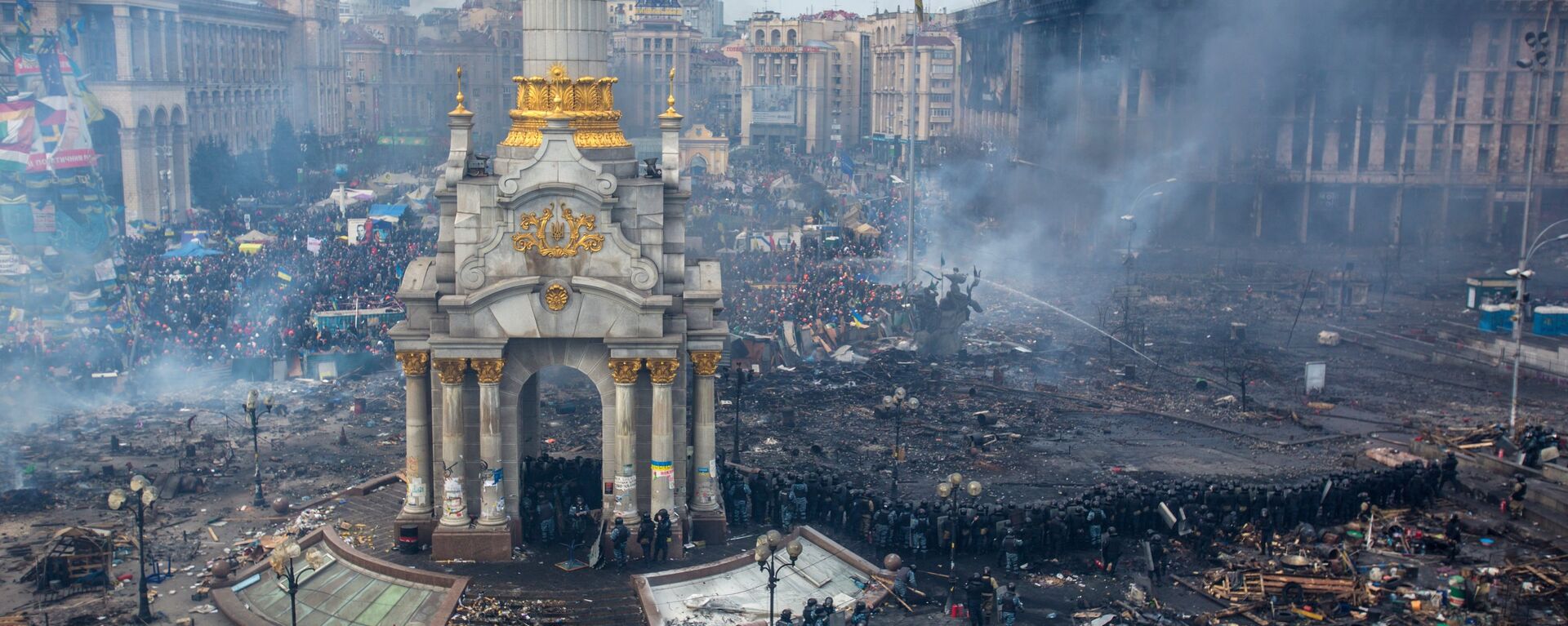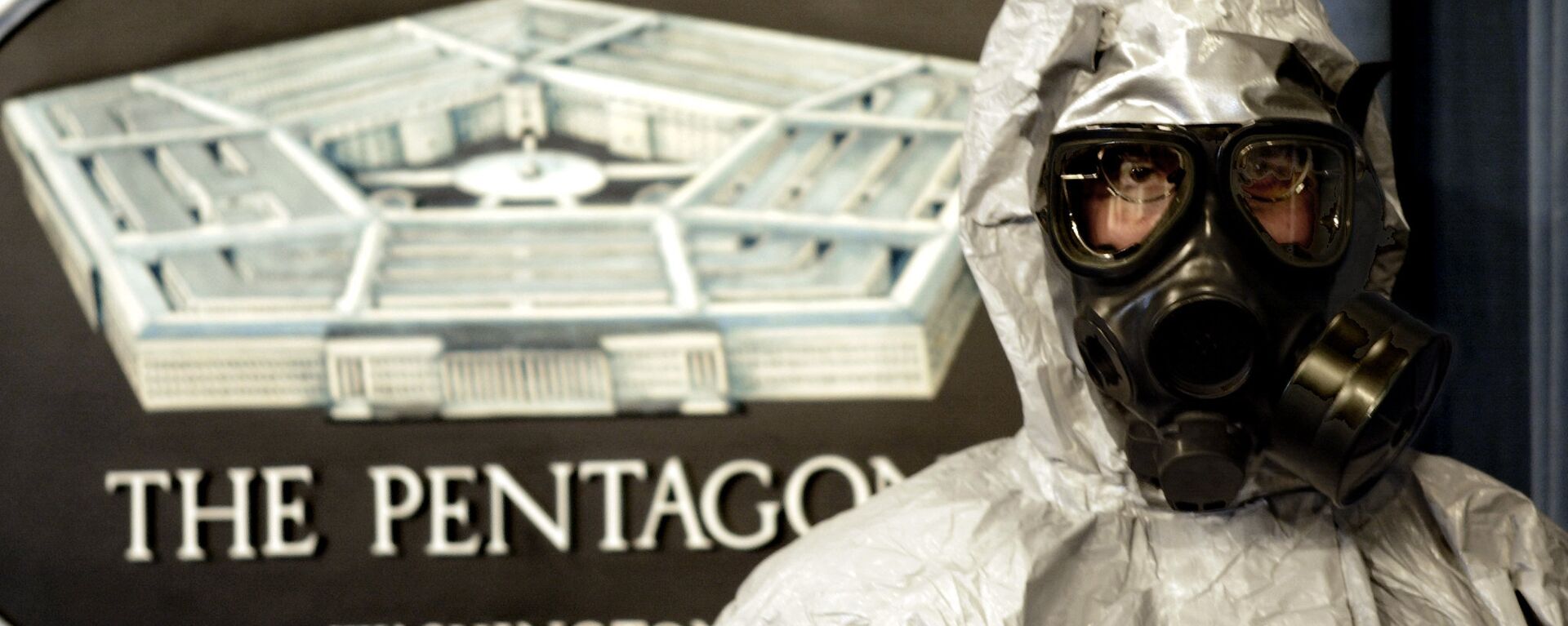https://sputnikglobe.com/20240528/ukraines-use-of-chemical-weapons-became-systematic-with-us-silent-consent---russian-mod-1118663254.html
Ukraine's Use of Chemical Weapons Became Systematic With US' Silent Consent - Russian MoD
Ukraine's Use of Chemical Weapons Became Systematic With US' Silent Consent - Russian MoD
Sputnik International
The use by Ukrainian forces of poisonous substances and chemical riot control agents has acquired a systematic nature with the silent consent of Washington, Lt. Gen. Igor Kirillov, the head of the radiation, chemical and biological defense troops of the Russian armed forces, said on Tuesday.
2024-05-28T12:09+0000
2024-05-28T12:09+0000
2024-05-28T13:19+0000
ukraine
ukrainian armed forces
donetsk
pentagon
organization for the prohibition of chemical weapons (opcw)
russia
chemical weapons
chemical warfare
military
washington
https://cdn1.img.sputnikglobe.com/img/07e8/05/1c/1118663601_0:51:2242:1312_1920x0_80_0_0_fa4011a86856da4044ef56dfdf94cd3e.jpg
"With Washington's tacit approval, the use of poisonous substances and chemical riot control agents by Ukrainian militants during their special operations has become systematic," Kirillov said at a briefing."Numerous cases of the Ukrainian side using the irritant substance chloropicrin, often mixed with chloroacetophenone, have been recorded in the Donetsk region, in the settlements of Bogdanovka, Gorlovka, Kremenovka, and Artyomovsk (Bakhmut)," he added. Kirillov recalled that Ukrainian neo-Nazis first used the dangerous substance chloropicrin against Euromaidan opponents during the siege of the Trade Union House in Odessa on May 2, 2014. He noted that Russian law enforcement agencies conducted an investigation that identified the perpetrators of the terrorist act.According to Kirillov, the use of this toxic substance was indicated by the militants' possession of pre-prepared filtering gas masks, the appearance of characteristic yellow-green smokefire broke out at the Trade Union House , and attempts to mask the use of toxic chemicals with the aftermath of the fire.Recently, Kiev used gas grenades containing the irritant substance CS against Russian servicemen. "Hand grenades with chemical irritants, labeled Teren-6, were dropped from Ukrainian UAVs onto positions of Russian troops, and a stash containing these munitions was discovered in the territory of Donetsk. According to testimony from Ukrainian prisoners of war, assault groups of the Ukrainian Armed Forces are equipped with such grenades," the official added.The Ukrainian armed forces also used the chemical agent BZ against Russian servicemen.Kirillov noted that Ukrainian Armed Forces also use other other listed chemicals."We are referring to instances of using the combat chemical agent BZ against Russian servicemen in August 2022 and silyl acid in February 2023," he explained."The statements from Ukrainian military representatives about their possession of phosphorus organic compounds, including analogs of the combat chemical agent Tabun (GA), raise particular concern," Kirillov added.He added that Ukraine is requesting antidotes and gas masks in excessive quantities, indicating plans for the use of toxic substances.In addition, Ukrainian nationalists continue in their attempts to destroy chemically hazardous facilities in the Donetsk and Lugansk People's Republics."The attempts by Ukrainian nationalists to destroy chemically hazardous facilities in the territories of the Donetsk and Lugansk People's Republics persist, thereby creating a threat of chemical contamination to the civilian population of the regions," Kirillov said. He recalled that industrial facilities such as Zarya in the city of Rubezhnoye, Azot in Severodonetsk, and the Koksokhim plant in Avdeyevka have repeatedly been subjected to massive rocket attacks.US Continue to Develop New Chemical WeaponsThe Pentagon continues to develop new and upgrade existing non-lethal chemical munitions and other chemical weapons delivery systems."According to available information, the Pentagon continues to develop new and upgrade existing non-lethal chemical munitions and other chemical weapons delivery systems, such as 120mm mortar rounds, 155mm artillery shells, and 120mm tank rounds," Kirillov said at the briefing.OPCW turns a blind eye to the fact that the US is still storing highly toxic reactive masses in chemical weapons destruction facilities. "I would like to draw your attention once again to the fact that according to the deadlines set by the OPCW, the United States should have completed the destruction of its declared chemical weapons stockpiles by 2007. However, despite the economic potential, they did not achieve this until 2023, twice postponing the deadline, citing financial, organizational, and technical difficulties. The United States still retains highly toxic reactive masses at chemical weapons destruction facilities. The Organization for the Prohibition of Chemical Weapons does not seem to notice this fact," he said.The US has also developed a legal framework that regulates a wide range of scenarios for the use of chemical agents by the US armed forces, Kirillov added."Washington has not only not renounced the use of chemical agents, but has also enshrined the possibility of their use at the legislative level. Thus, the United States has adopted a combined arms manual on the use of non-lethal weapons," Kirillov told reporters, adding that it defines the procedure for the use of non-lethal chemical weapons by military units during special, humanitarian, anti-terrorist and peacekeeping operations.If previously the US talked about using such weapons only in response to the enemy chemical aggression, an important aspect of the new rules is the ability to use toxic chemicals unilaterally," the official said.
https://sputnikglobe.com/20240219/how-euromaidan-triggered-ukraines-nine-year-war-on-donbass-1116864693.html
https://sputnikglobe.com/20230209/from-sarin-to-bz-what-are-chemical-weapons-and-how-deadly-are-they-1107109577.html
https://sputnikglobe.com/20240507/after-positioning-military-biolabs-around-the-globe-us-officials-urge-biodefense-buildup-1118314833.html
ukraine
donetsk
russia
washington
Sputnik International
feedback@sputniknews.com
+74956456601
MIA „Rossiya Segodnya“
2024
Sputnik International
feedback@sputniknews.com
+74956456601
MIA „Rossiya Segodnya“
News
en_EN
Sputnik International
feedback@sputniknews.com
+74956456601
MIA „Rossiya Segodnya“
Sputnik International
feedback@sputniknews.com
+74956456601
MIA „Rossiya Segodnya“
russia, ukraine, us, checmical weapons, ukraine uses checmical weapons, us develop checmical weapons, us allows ukraine to use chemical weapons against russian forces
russia, ukraine, us, checmical weapons, ukraine uses checmical weapons, us develop checmical weapons, us allows ukraine to use chemical weapons against russian forces
Ukraine's Use of Chemical Weapons Became Systematic With US' Silent Consent - Russian MoD
12:09 GMT 28.05.2024 (Updated: 13:19 GMT 28.05.2024) The use of poisonous substances and chemical riot control agents by Ukrainian forces has become systematic with the tacit approval of Washington, Lieutenant General Igor Kirillov, the head of the Russian Armed Forces' radiation, chemical and biological defense troops, said on Tuesday.
"With Washington's tacit approval, the use of poisonous substances and chemical riot control agents by Ukrainian militants during their special operations has become systematic," Kirillov said at a briefing.
"Numerous cases of the Ukrainian side using the irritant substance
chloropicrin, often mixed with
chloroacetophenone, have been recorded in the Donetsk region, in the settlements of
Bogdanovka, Gorlovka, Kremenovka, and Artyomovsk (Bakhmut)," he added.
Kirillov emphasized that while chloroacetophenone is classified as a chemical riot control agent, chloropicrin is listed in Schedule 3 of the Chemical Weapons Convention.
Kirillov recalled that Ukrainian neo-Nazis first used the dangerous substance chloropicrin against Euromaidan opponents during the siege of the
Trade Union House in Odessa on May 2, 2014.
"There are grounds to believe that the action carried out in Odessa was premeditated, meticulously planned to exploit the effects of the toxic substances used, aimed at inflicting maximum casualties," Kirillov added.
He noted that Russian law enforcement agencies conducted an investigation that identified the
perpetrators of the terrorist act.
According to Kirillov, the use of this toxic substance was indicated by the militants' possession of pre-prepared filtering gas masks, the appearance of characteristic yellow-green smokefire broke out at the
Trade Union House , and attempts to mask the use of toxic chemicals with the aftermath of the fire.
Recently, Kiev used gas grenades containing the irritant substance CS against Russian servicemen.
"The Russian side has recorded and confirmed cases of the Ukrainian Armed Forces using munitions not only loaded with chloropicrin but also with other chemical irritants. Gas grenades of American production containing the substance CS were employed against Russian servicemen in the Krasny Liman and Boguslav regions," Kirillov said.
"Hand grenades with chemical irritants, labeled
Teren-6, were dropped from
Ukrainian UAVs onto positions of Russian troops, and a stash containing these munitions was discovered in the territory of Donetsk. According to testimony from Ukrainian prisoners of war, assault groups of the Ukrainian Armed Forces are equipped with such grenades," the official added.
CS is an irritant chemical. It is a white, solid, slightly volatile crystalline substance with a pepper-like odor. It is sparingly soluble in water, moderately soluble in alcohol, and freely soluble in acetone and chloroform. Under combat conditions, it is dispersed as an aerosol. CS at low concentrations is irritating to the eyes and upper respiratory tract, while at high concentrations it causes burns to exposed skin areas and in some cases paralysis of the respiratory and circulatory systems leading to death.
The Ukrainian armed forces also used the
chemical agent BZ against Russian servicemen.
"Ukrainian armed formations also use other listed chemicals. We refer to cases of use of the combat chemical agent BZ against Russian servicemen in August 2022 and silyl acid in February 2023," he said at the briefing."

9 February 2023, 13:14 GMT
Kirillov noted that Ukrainian Armed Forces also use other
other listed chemicals.
"We are referring to instances of using the combat chemical agent BZ against Russian servicemen in August 2022 and silyl acid in February 2023," he explained.
"The statements from Ukrainian military representatives about their possession of phosphorus organic compounds, including analogs of the combat chemical agent Tabun (GA), raise particular concern," Kirillov added.
He added that Ukraine is requesting antidotes and gas masks in excessive quantities, indicating
plans for the use of toxic substances.
"The requests from Ukraine for the supply of antidotes, gas masks, and other personal protective equipment in volumes that are clearly excessive testify to plans for large-scale use of toxic substances," Kirillov said.
In addition, Ukrainian nationalists continue in their attempts to destroy chemically hazardous facilities in the
Donetsk and Lugansk People's Republics.
"
The attempts by Ukrainian nationalists to destroy chemically hazardous facilities in the territories of the Donetsk and Lugansk People's Republics persist, thereby creating a threat of chemical contamination to the civilian population of the regions," Kirillov said.
He recalled that industrial facilities such as Zarya in the city of Rubezhnoye, Azot in Severodonetsk, and the Koksokhim plant in
Avdeyevka have repeatedly been subjected to massive rocket attacks.
US Continue to Develop New Chemical Weapons
The
Pentagon continues to develop new and upgrade existing non-lethal chemical munitions and other chemical weapons delivery systems.
"According to available information, the Pentagon continues to develop new and upgrade existing non-lethal chemical munitions and other chemical weapons delivery systems, such as 120mm mortar rounds, 155mm artillery shells, and 120mm tank rounds," Kirillov said at the briefing.
"No less than $10 million is allocated annually for their procurement for use in combat zones," he added.
OPCW turns a blind eye to the fact that the US is still storing highly toxic reactive masses in chemical weapons destruction facilities. "I would like to draw your attention once again to the fact that according to the deadlines set by the OPCW, the United States should have completed the destruction of its declared chemical weapons stockpiles by 2007. However, despite the economic potential, they did not achieve this until 2023, twice postponing the deadline, citing financial, organizational, and technical difficulties. The United States still retains highly toxic reactive masses at chemical weapons destruction facilities. The Organization for the
Prohibition of Chemical Weapons does not seem to notice this fact," he said.
The US has also developed a legal framework that regulates a wide range of scenarios for the use of chemical agents
by the US armed forces, Kirillov added.
"Washington has not only not renounced the use of chemical agents, but has also enshrined the possibility of their use at the legislative level. Thus, the United States has adopted a combined arms manual on the use of non-lethal weapons," Kirillov told reporters, adding that it defines the procedure for the use of non-lethal chemical weapons by military units during special, humanitarian, anti-terrorist and peacekeeping operations.
If previously the US talked about using such weapons only in response to the
enemy chemical aggression, an important aspect of the new rules is the ability to use toxic chemicals unilaterally," the official said.
"Thus, the United States has created a legal framework that regulates a wide range of scenarios for the use of chemical weapons by the armed forces," Kirillov said.
The United States allocates at least $10 million annually to purchase non-lethal chemical munitions for use in combat areas, the official said, adding that the Pentagon continues to develop new and modernize existing non-lethal chemical munitions.





